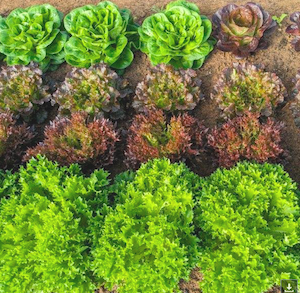yard gardeners and farmers. You are welcome to add your wisdom and share growing and harvest tips and recipes. Send to proorganicbelize@gmail.com
Tropical Garden Grow Guide
Where you are the student and the teacher
November 2023 Plant of the Month

Photo Credit Clayton Carpenter
| Botanic
name: |
Lactuca sativa |
| Plant
type: |
Annual, leafy green |
| Family: |
Asteraceae |
| Sun exposure: |
5-6 hrs daily |
| pH: |
6.0-6.5 |
| Soil type: |
slightly acid, |
| Soil preference: |
fertile, moist, soft, loamy, rich in
organic matter or humus |
| Soil depth: | 1/4-1/2 in of fine soil |
Plant type: An annual leafy green plant of the Asteraceae family. Leaf lettuce is the variety that is commonly successfully grown in Belize. There are many other varieties of lettuce and greens. Some are too tender to survive the hot tropical climate; however, a few others may be grown in Belize to add to your nutritious and healthy salads. Leaf lettuce seems to do best and is most tolerant of the heat. According to an article in 'Belize Breaking News', on February 1, 2022, Gary Rameriz supports growing all kinds of leaf lettuce, but does not recommend growing iceberg head lettuce. He said it can be done, but this variety of lettuce grows better in a cooler climate
Lettuce plants do not thrive in the hot sun. Lettuce plants may be intercropped with other plants, such as pole beans to provide nitrogen and shade.
How to grow: Lettuce may be started from seeds or seedlings in the garden, in raised beds or in containers around the porch or railings of your house. The National Gardening Association (U.S.A.) recommends wide row planting. Here is how it’s done: dig up an area in your garden about 2 feet wide and six feet long. Break up the soil with a hoe or rake and smooth it over. Evenly sprinkle seeds over the soil, (a few radish seeds may be added to help mark the spot). Then cover the seeds with about ¼ to ½ inch of fine well tilled topsoil, firm the soil using the back of a hoe or your hands. Be careful not to step on your lettuce bed in order to avoid compressing the soil. Water the area thoroughly with a fine sprinkle or use a mist nozzle. A soaker hose may be used for future watering. Seeds germinate anywhere from 10-21 days post planting. Be sure to keep the soil moist, but never soggy. Making plantings about every two weeks helps to ensure fresh lettuce all year round.
Disease or insect control: A few onion or garlic chives planted among the lettuce helps to control aphids. Be sure to rotate the lettuce beds to help control bugs and regenerate the soil.
To harvest: Thinning the lettuce to about 4 inches apart allows you to harvest the tiny leaves as microgreens. To harvest fully grown plants, cut them about 1 inch from the earth leaving the stem and roots in the ground. They will resprout leaves. Watch for 'bolting' in the hot weather. The energy of the lettuce produces a stem that goes to seed. If your lettuce bolts, be sure to save the seeds.
Health benefits: Lettuce contains vitamins A and K, folate, antioxidants and fiber. Lettuce also contains lactucarium, an ingredient that is calming for anxiety.
Recipe: Lettuce is most commonly used as the main ingredient in salads. Lettuce leaves also make an attractive sandwich wrap. Wash larger sized lettuce leaves and fill them with your favorite sandwich ingredients. Leaves may also be chopped and added to soups and casseroles. Leaves may be stored in the refrigerator for about 10 days or longer if you store them in an air-tight container. If your lettuce is wilted you may be able to revive it by placing the leaves in a bowl of cold water with a few ice cubes added for about 10 minutes. If they do not perk up, you could add them to soup or a smoothie.